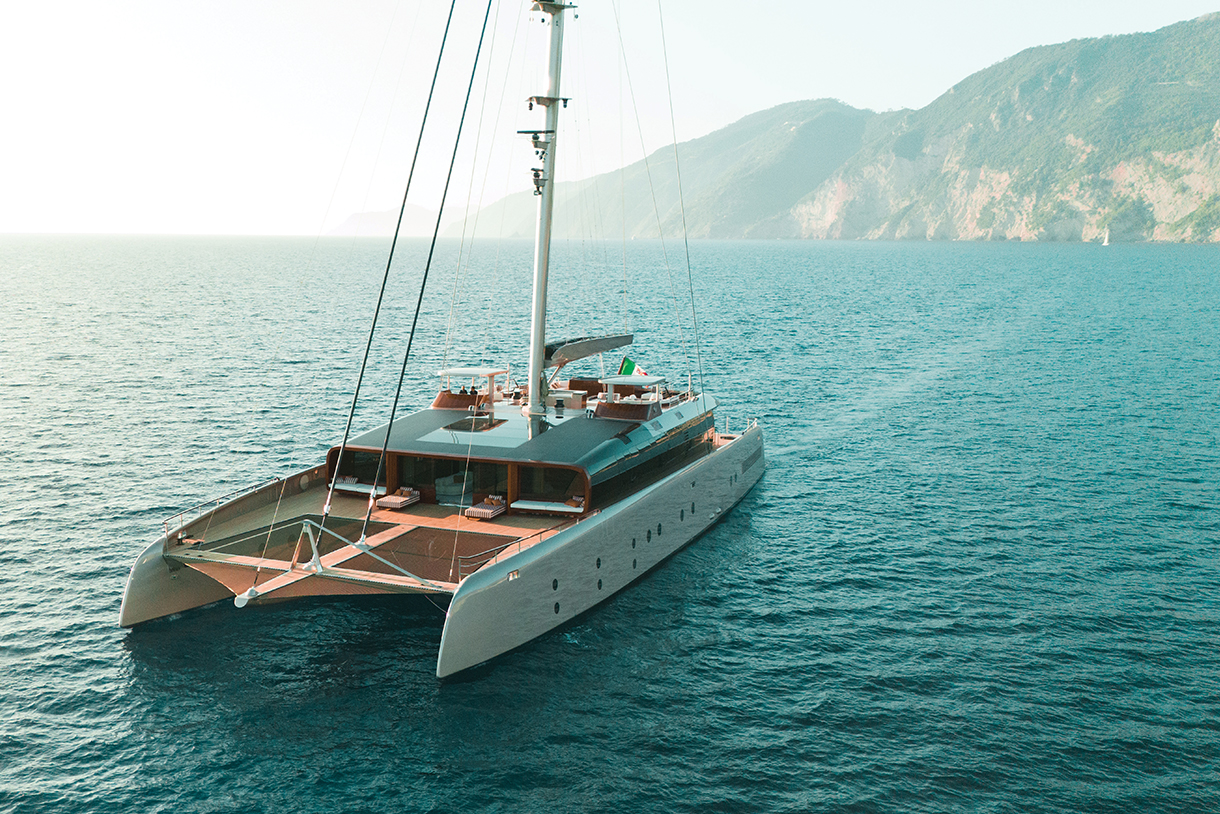
The ArtExplorer
Culture
A Mobile Museum at Sea
by Brooke Mazurek
ArtExplorer
In 2019, at the age of 49, tech entrepreneur Frédéric Jousset journeyed from France to the Himalayas to climb Mount Everest—“The Holy Mother,” as it’s known in Tibet. In the scheme of archetypal journeys that could have unfolded with a man ascending a ginormous mountain into the sky, Jousset’s ranks up there. He reached the 29,000-foot summit, saw his purpose through a new lens, returned to Paris, and changed his life. “I had my epiphany,” he says.For 15 years, Jousset had been a patron of the arts. After selling shares of his company Webhelp in 2005, he became a board member of the Louvre and Beaux-Arts de Paris. “I sponsored initiatives related to access, I built a website for disabled people and children, I sponsored conferences and brought mediators to hospitals and prisons,” he says. But all along the way, he began to piece together a greater macro-level problem.
“I came to realize that culture is a bit like religion in a sense. Unless it’s passed on to you by your family environment, it’s quite seldom that spontaneously at the age of 40 or 50, you turn up to a museum or an opera or a theater.” In Western Europe, only a fraction of the population had access to cultural institutions, and that population mostly resided in big cities. Sure, 200 years of economic growth and public policy had brought access to housing, education, and health care. “But art? Something that makes better people, makes society more creative, and gives people a chance to look at the world differently? To me this was, and is, an urgent cause.”
On Everest, Jousset saw that he could spend the rest of his life as another sponsor or gala attendee, another name on a museum wing. Or he could fully leave his company and apply what he’d learned from the business world—“the efficiency, the technology, the measurement, the KPIs”—to a charity that would change the world’s access to art in provocative ways. “I thought: If people don’t come to museums or the opera or the cinema, we should be knocking at their doors wherever they live, make it eventful, and make it free,” he says.
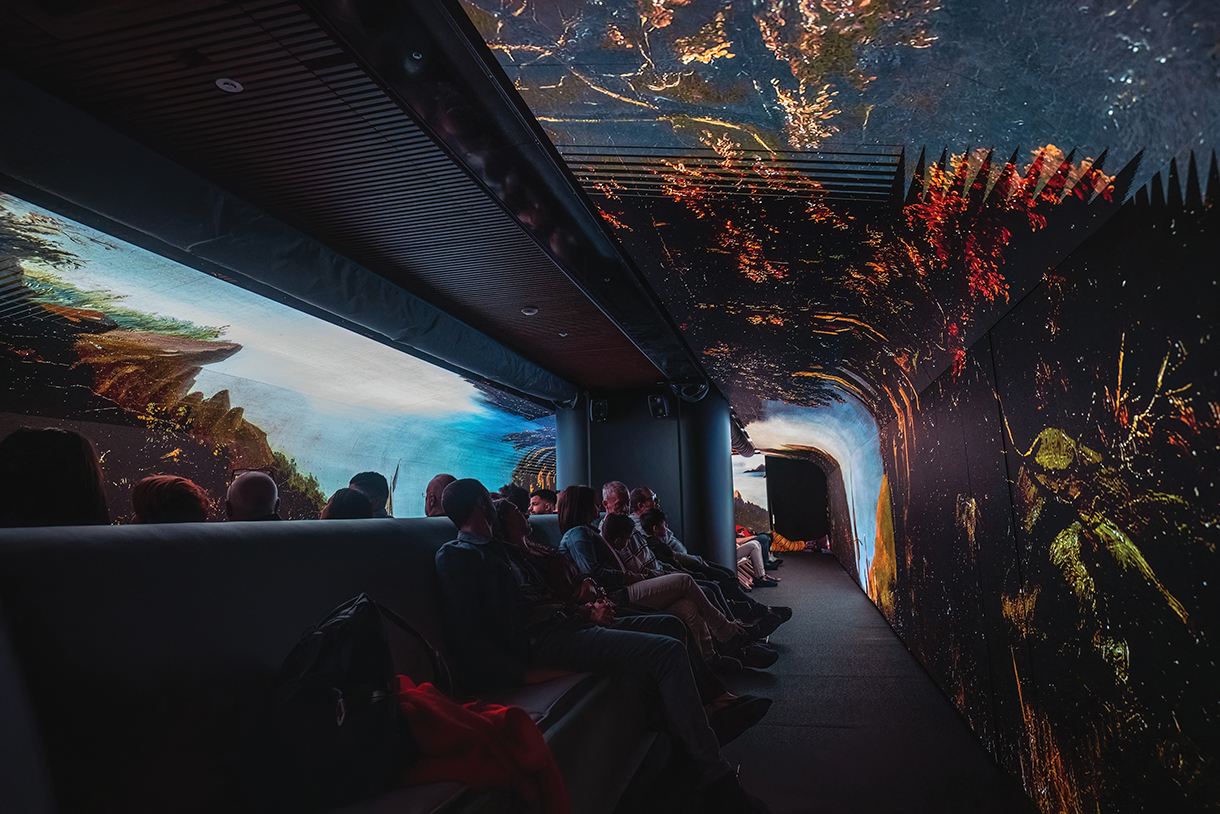
Six months later, Art Explora Foundation (artexplora.org) was born.
Committed to making art a borderless experience that is accessible for all, the organization began with the launch of two mobile museums housed inside of two massive long-haul trucks in 2020. The trucks arrived in suburbs and remote villages where children, teens, and adults of all ages were able to experience exhibitions developed in partnership with the Tate in London and Paris’ Centre Pompidou. With 60,000 visitors per year, per truck, the effort was a rapid and resounding success. “It was confirmation that this idea of mobility was a good one,” says Jousset. And with that confirmation, there quickly arose another thought: Why not try a boat?
With about 60 percent of the world’s population living within 60 minutes from the shore, Jousset perceived the ocean as the great connector. He envisioned marinas filled with free festivals surrounding the exhibitions. Plus, superyachts were like magnets. “Thousands of people will come to the harbors of St. Tropez and look at these superyachts from a distance, even if they can’t come on board.” An environmentally friendly superyacht that was open to the public for free?
Committed to making art a borderless experience that is accessible for all, the organization began with the launch of two mobile museums housed inside of two massive long-haul trucks in 2020. The trucks arrived in suburbs and remote villages where children, teens, and adults of all ages were able to experience exhibitions developed in partnership with the Tate in London and Paris’ Centre Pompidou. With 60,000 visitors per year, per truck, the effort was a rapid and resounding success. “It was confirmation that this idea of mobility was a good one,” says Jousset. And with that confirmation, there quickly arose another thought: Why not try a boat?
With about 60 percent of the world’s population living within 60 minutes from the shore, Jousset perceived the ocean as the great connector. He envisioned marinas filled with free festivals surrounding the exhibitions. Plus, superyachts were like magnets. “Thousands of people will come to the harbors of St. Tropez and look at these superyachts from a distance, even if they can’t come on board.” An environmentally friendly superyacht that was open to the public for free?
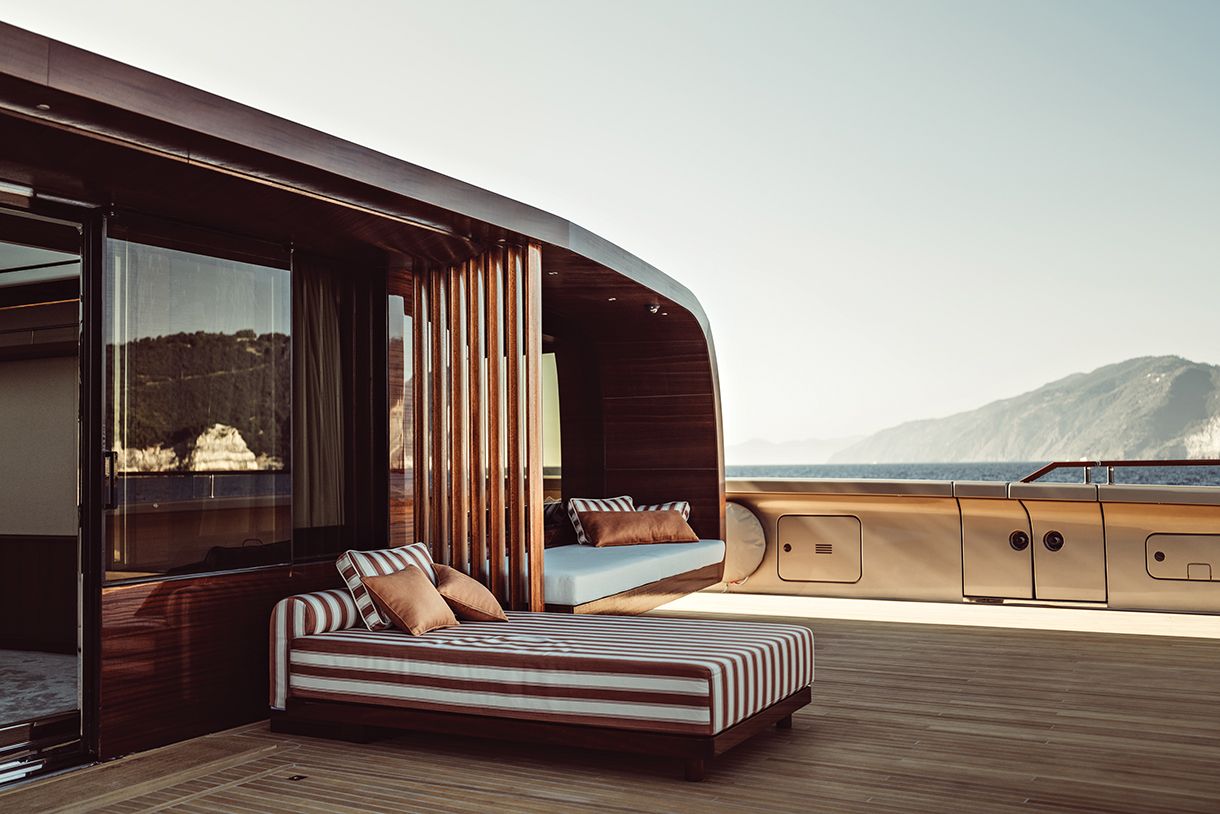
By design standards, the ArtExplorer, which officially set sail in March, is exquisite. Creatively helmed by Axel de Beaufort, who is perhaps best known for overseeing some of Hermès’ most remarkable luxury projects, the 154-foot-long vessel is the world’s largest sailing catamaran. It’s also a floating museum. Apart from the interior and exterior designs, which blend timeless elegance with sleek modernity, the aluminum-bodied vessel also seamlessly incorporates sustainability into its profile. There is woodwork that curves and glows in the light, and creamy boucle textures. There’s also 700 square feet of solar panels on the deckhouse and a fully automated, all-carbon sail plan that allows the catamaran to reach between 11 and 13 knots, even in low-wind conditions.
“I’m a big believer that cats are the future of the superyacht industry,” says Jousset, an avid sailor, noting that clashes over private jets have begun spilling into the world of superyachts. “The cat brings the space and luxury of the superyacht; it’s just a more efficient way of sailing.” The hulls are thinner, allowing it to move faster with less fuel consumption. It also brings guests closer to the water. “It’s not like you’re in a building on the fifth floor looking out at the sea from the balcony.” You’re moving right there with it. You become a part of the current itself.
“I’m a big believer that cats are the future of the superyacht industry,” says Jousset, an avid sailor, noting that clashes over private jets have begun spilling into the world of superyachts. “The cat brings the space and luxury of the superyacht; it’s just a more efficient way of sailing.” The hulls are thinner, allowing it to move faster with less fuel consumption. It also brings guests closer to the water. “It’s not like you’re in a building on the fifth floor looking out at the sea from the balcony.” You’re moving right there with it. You become a part of the current itself.

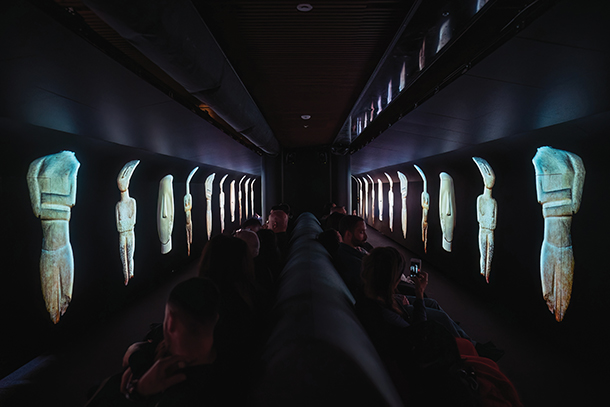
To envision the world’s first floating museum is one thing. But to actually realize the seed dream into existence is another—and it wasn’t without its challenges. Most superyachts will accommodate up to 12 people, but the ArtExplorer needed to welcome 2,000 people per day, while offering a fully immersive exhibition experience complete with 4K LED screens and state-of-the-art audio equipment. There were handicap accessibilities, harbor configurations, and the enormous heat generated by all the equipment to take into account—all while keeping the design within a superyacht-level paradigm of luxury.
If it sounds ambitious, it is. The son of an entrepreneurial father and a mother who was the chief curator at the Centre Pompidou at Beaubourg, Jousset remembers famous designers from the 1940s, ’50s, and ’60s coming by his family’s home to show sketches of prototypes that would eventually find their way into exhibitions. “Witnessing this creativity in motion was, for me, really fascinating.” He describes his father, someone Jousset always saw as far more brilliant than himself, “as more a man of ideas than of action. And when your dad has achieved a lot, but not everything, you think: ‘I can go the extra mile … and I should.’”
If it sounds ambitious, it is. The son of an entrepreneurial father and a mother who was the chief curator at the Centre Pompidou at Beaubourg, Jousset remembers famous designers from the 1940s, ’50s, and ’60s coming by his family’s home to show sketches of prototypes that would eventually find their way into exhibitions. “Witnessing this creativity in motion was, for me, really fascinating.” He describes his father, someone Jousset always saw as far more brilliant than himself, “as more a man of ideas than of action. And when your dad has achieved a lot, but not everything, you think: ‘I can go the extra mile … and I should.’”
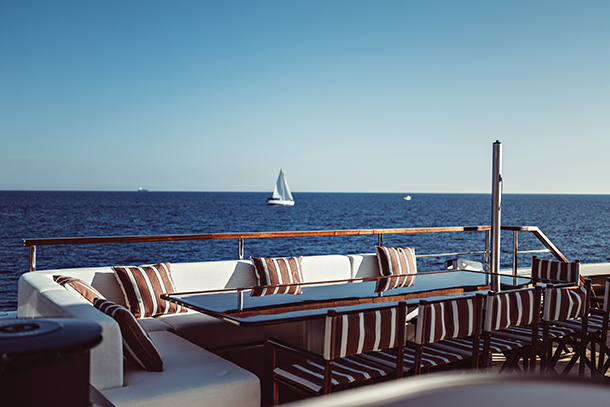
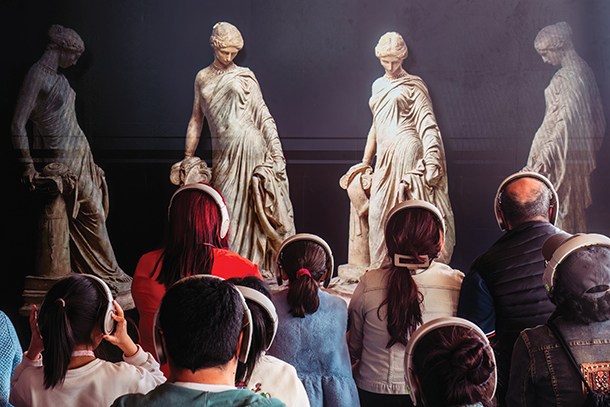
At present, ArtExplorer is completing a 15-port tour throughout the Mediterranean, where the public is invited to experience Présentes, an exhibition in collaboration with the Louvre that highlights female figures in Mediterranean civilizations. Starting this summer, however, ArtExplorer can also be privately chartered through Fraser Yachts for approximately $259,000/week.
Although the floating museum is partially financed through subsidies, it’s the private chartering structure that helps financially sustain ArtExplorer’s mission. In other words, guests who set sail on the six-bedroom supercat are helping to bring this first exhibition, and future ones, all over the globe. Jousset dreams of Africa, of crossing the Atlantic to the United States, and then sailing to Central America and down to Brazil. There are no limits, he insists. “The boat will definitely go everywhere.”
Photo credits: Courtesy ArtExplorer/Max Malth; ArtExplorer/Benoit Linero (3); Exposition Immersive at the Louvre: Courtesy ArtExplorer/Elisa von Brockdorff (3)
Although the floating museum is partially financed through subsidies, it’s the private chartering structure that helps financially sustain ArtExplorer’s mission. In other words, guests who set sail on the six-bedroom supercat are helping to bring this first exhibition, and future ones, all over the globe. Jousset dreams of Africa, of crossing the Atlantic to the United States, and then sailing to Central America and down to Brazil. There are no limits, he insists. “The boat will definitely go everywhere.”
Photo credits: Courtesy ArtExplorer/Max Malth; ArtExplorer/Benoit Linero (3); Exposition Immersive at the Louvre: Courtesy ArtExplorer/Elisa von Brockdorff (3)




